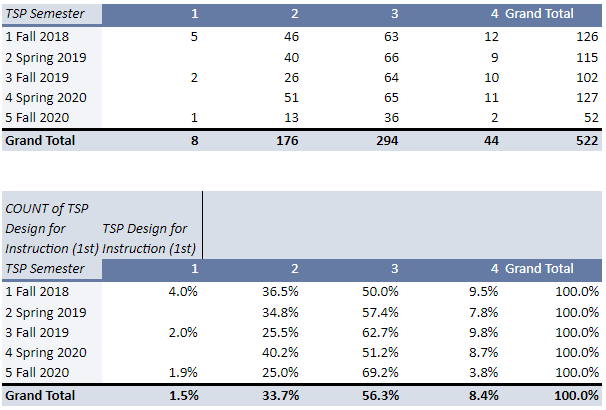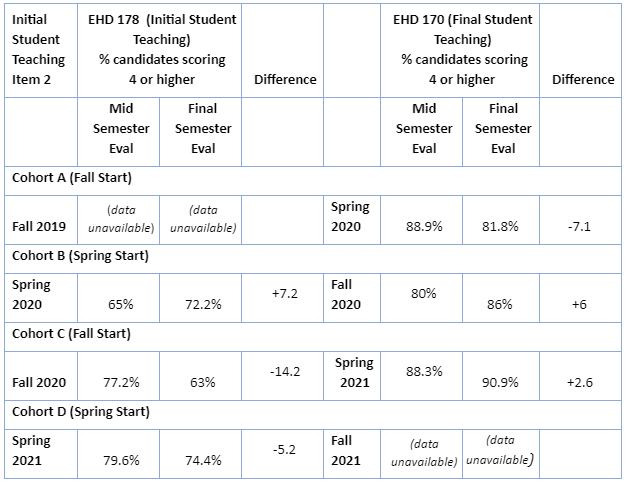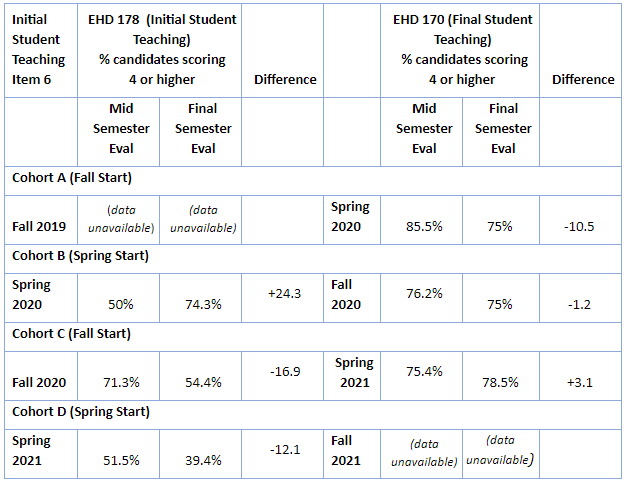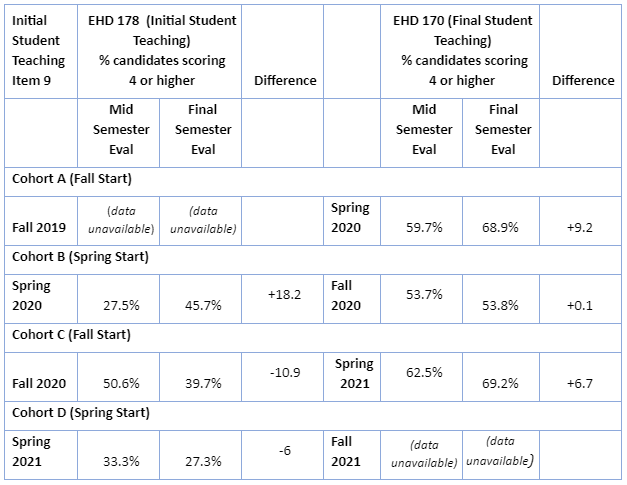AAQEP Accreditation
Standard 1 Aspect C
Standard 1c: Evidence shows that, by the time of program completion, candidates exhibit knowledge, skills, and abilities of professional educators appropriate to their target credential or degree, including: Culturally responsive practice, including intersectionality of race, ethnicity, class, gender identity and expression, sexual identity, and the impact of language acquisition and literacy development on learning
Data Sources & Analysis
CSU Educator Quality Center Completer Survey, Teaching Sample Project, and CREATe Rubric items 2, 6 and 9
Data Source 1
CSU Educator Quality Center Completer Survey
Description of Data Source:
Every year the CSU Educator Quality Center administers a survey to CSU teacher preparation
program completers at the time they complete their program. The routine, annual collection
of these data offer the program to look at Multiple Subject Program Completer perceptions
of preparedness longitudinally. Overall this survey tool aims to capture their perceptions
of preparation, and to measure their confidence in career placement and success. The
survey is aligned with the California Teaching Performance Expectations (TPE), serving
as a guide to the curriculum and clinical experiences of the Multiple Subject Credential
Program. This survey reports important insight into how our graduates’ perceive their
level of preparedness resulting from completing our program.
Perspective Captured from Data Source:
Candidate who completed the program from 2017-2020.
Rationale for Using Data Source:
Seven (7) items from the CSU Educator Quality Center’s Completer Survey were used
to evaluate the Multiple Subject Credential Program candidates’ ability to engage
in culturally responsive practices. This measure provides the candidate perspective
on their teacher preparation experience, which is juxtaposed with the Fieldwork Evaluation
score provided in Data Source 3 below from the university coach perspective.
Specific Elements of Data Source:
For this data source, we are focusing on the question: “How well are teacher candidates
prepared to meet teaching competencies?” related to culturally and linguistically
sustaining practices which includes asset-based pedagogies and funds of knowledge
frameworks in teaching:
- Plan, design, implement and monitor instruction, making effective use of instructional time to maximize learning opportunities and provide access to the curriculum for all students by removing barriers and providing access through instructional strategies that include:
-
- To engage in culturally responsive teaching.
- To plan instruction based on students' prior knowledge, academic readiness, language proficiency, cultural background, and individual development.
- To use knowledge of students' strengths and prior experiences to engage them in learning.
- To create a productive learning environment with high expectations for all students.
- To connect classroom learning to the real world.
- To meet the instructional needs of English learners.
- To use the California English Language Development (ELD) Standards to guide instruction for English learners in my primary subject.
Definition of Success for Each Element:
The survey responses range from 1 - “Not At All Prepared” to 5 - “Very Well prepared.”
It is our program's goal to have 85% or more of candidates indicate positive preparedness
perceptions within the 3 - 5 range or from “Adequately Prepared” to “Well Prepared”
to “Very Well Prepared.”
Displays of Analyzed Data:
The data displayed below reflects the following “Multiple Subject Program Completer
cohorts”: 2017-2018, 2018-2019, and 2019-2020.
Figure 1: 2017-2018 Multiple Subject Program Completers (N 179)
Figure 2: 2018-2019 Multiple Subject Program Completers (N 243)
Figure 3: 2019-2020 Multiple Subject Program Completers (N 230)
Link to Full Dataset: The link to the full dataset is unavailable. However, if reviewers would like to view the CSU Educator Quality Center Data Dashboards, we are happy to set up a time to provide them access by sharing screens in a Zoom session.
Interpretation of Data:
Multiple Subject Program Completers’ (MSPC) perceptions of their preparedness for
TPE related to culturally and linguistically sustaining practices was overwhelmingly
positive across all three years. No items fell below 90% in positive perception. MSPC
perceptions of preparedness to plan, design, and implement culturally responsive teaching
increased each year to that of the most positive perception of preparedness by 2020.
The use of the California English Language Development Standards to guide instruction
for English learners in my primary subject sustained the least positive perception
of preparedness all three years. Upon exiting our credential programs, candidates
overall feel well prepared to design and implement instructional experiences for all
students, including linguistically and culturally appropriate learning experiences
for the diverse learners in our Central Valley contexts.
Data Source 2
Fresno Assessment of Student Teachers II (FAST II): Teaching Sample Project
Description of Data Source:
The FAST is a Teaching Performance Assessment system designed specifically for use
in the teacher preparation program in the Kremen School of Education and Human Development
at California State University, Fresno. The FAST instrument assesses the pedagogical
competence of teacher candidates with regard to the Teaching Performance Expectations
(TPE’s). Although the FAST was originally developed and implemented about sixteen
years ago, it has recently been modified to align with the revised assessment standards
from California Commission on Teaching Credentialing (CCTC). Our Multiple Subject
Program was also being revised at the same time to align with the new Teaching Performance
Expectations. The revised assessment was piloted during the Fall 2017/Spring 2018
academic year and was approved by the California Department of Education in August
2018.
Perspective Captured from Data Source: Faculty and Coaches
Rationale for Using Data Source:
As mentioned above, the Teaching Sample Project (TSP) is one of two tasks in the Fresno
Assessment of Student Teachers (FAST) that collectively measure the pedagogical competence
of teacher candidates and interns for Preliminary Teaching Credentials in California
and serve as information useful for determining program quality and effectiveness.
Candidates complete the TSP during the final phase of the program. To complete the
TSP, candidates identify the classroom context (i.e. students and classroom environment);
plan and teach a series of at least 5 cohesive lessons (a unit of study) with a focus
on content knowledge and literacy; assess students’ learning before, during, and after
the unit; and reflect on the effectiveness of the instruction. The overall assignment
is scored using a rubric.
Specific Elements of Data Source:
For the purposes of determining whether or not our candidates exhibit knowledge of
culturally responsive pedagogy, we chose to focus on the rubric dimension “Design
for Instruction.” In this section, the candidate designs instruction for specific
learning outcomes, student characteristics and needs, and learning contexts.
The work should address the following TPEs:
TPE 1: Engaging and Supporting All Students in Learning;
TPE 3: Understanding and Organizing Subject Matter for Student Learning;
TPE 4: Planning Instruction and Designing Learning Experiences for All Students; and
TPE 5: Assessing Student Learning
Definition of Success for Each Element:
At minimum, candidates must score at a level 2 (or higher) on this rubric which indicates
that they have “Met Expectations” in order to pass. The rubric has the following scale:
1 - Does Not Meet Expectations; 2 - Meets Expectations; 3 - Meets Expectations at
a High Level; and 4 - Exceeds Expectations. Our program goal is for candidates to
score at a 3 on each rubric dimension.
Displays of Analyzed Data:
Figure 4: TSP Scores, 2018-20
Link to Full Dataset: MS FAST Scores TSP
Interpretation of Data:
We present the data for the Teaching Sample Project - Design for Instruction component
for the previous five semesters, from Fall 2018 to Fall 2020. The data illustrates
that upon program completion, candidates demonstrate strong abilities to design instruction
that is responsive to our diverse students’ needs, including emergent bilingual students
labeled “English language learners.” The passing rate, with a score of 2 or higher,
has been consistently high: between 96% to 100%, making the average passing rate during
the last five semesters at 98.4%. As noted earlier, our program goal is for all of
our candidates to score at a level 3 or higher. During the last five semesters, the
percentage of students scoring at a 3 or higher have been the following: F 2018 59.5%;
Sp 2019 65.2%; F 2019 72.5%; Sp 2020 60%; F 2020 73%. This trend shows an overall
increase from Fall 2018 to Fall 2020 in students scoring at a 3 or higher, getting
us closer to our program goal. There is a downward turn during Spring 2020, which
can be largely attributed to the pandemic and the impact that it had on our candidates'
clinical practice. However, the significant increase during Fall 2020 is a great sign
that even during a pandemic, candidates were able to show their abilities to design
effective instruction in their mostly virtual clinical practice contexts.
Data Source 3
Midterm & Final Fieldwork Evaluation (CREATe Rubric used formatively)
Description of Data Source:
The third measure is the Continuum of Reflective, Engaging, and Accessible Teaching
(CREATe) Rubric Midterm and Final Fieldwork Evaluation used by coaches to evaluate
candidates in their field work preparation at two intervals. CREATe integrates equity
and culturally and linguistically responsive pedagogy into the clinical practice feedback
cycle, measuring candidate development in 14 areas. This locally developed observation
tool provides a common language for preservice teachers, coaches, faculty, mentors,
and district administrators to orient their feedback in an actionable manner. Through
synthesis of existing district observation tools, and by aligning this synthesis to
the new Teacher Performance Expectations (2016 California Commission on Teacher Credentialing/
CCTC adopted Teaching Performance Standards/TPEs), the CREATe Rubric consists of 14 items organized within the following four domains: 1) Positive Environment, 2) Instructional Design and Implementation, 3) Rigorous
and Appropriate Content, and 4) Reflection-In-Action. Each of the 14 items is rated
along a seven-point developmental continuum with the following rating categories:
Unobserved, Attempting, Exploring, Emerging, Developing, Skillful, and Masterful.
Each rating category has an anchor descriptor that operationalizes each of the 14
items with action-oriented, observable “look-fors.”
Perspective Captured from Data Source: University Coach
Rationale for Using Data Source:
The CREATe Rubric, aligned to the California Teacher Performance Expectations (TPEs)
and California Standards for the Teaching Profession (CSTPs), is a research-based
observation rubric for use with teachers along the novice to expert continuum. This
tool is intended to be used formatively to guide candidate development of prioritized
skills, rather than as a summative assessment. In Phases 2 and 3, coaches use the instrument to evaluate candidates’ performance at the middle and again at the end of the semester.
Three (3) items have been chosen to formatively assess the candidates’ implementation
of instruction that is inclusive, takes into account students’ backgrounds, and is
based on the research-based pedagogical approaches for the teaching of culturally,
linguistically, and neurologically diverse learners during the middle and end of the
semester during both initial and final student teaching.
Specific Elements of Data Source:
For the purposes of determining whether or not our candidates have the necessary knowledge
of and skills to implement culturally and linguistically sustaining practices, we
chose to focus on the following rubric items:
Item 2: Inclusive Learning Environment
Aligned to TPE 2.2: Create learning environments (i.e., traditional, blended, and online) that promote productive student learning, encourage positive interactions among students, reflect diversity and multiple perspectives, and are culturally responsive
Aligned to TPE 2.3: Establish, maintain, and monitor inclusive learning environments that are physically, mentally, intellectually, and emotionally healthy and safe to enable all students to learn, and recognize and appropriately address instances of intolerance and harassment among students, such as bullying, racism, and sexism.
Item 6: Funds of Knowledge
Aligned to TPE 1.1 Apply knowledge of students, including their prior experiences, interests, and social-emotional learning needs, as well as their funds of knowledge and cultural, language, and socioeconomic background, to engage them in learning.
Item 9: Research-Based Instruction for Emergent Bilinguals and Students with Special Needs
Aligned to TPE 6.1: Provide a supportive learning environment for students' first and/or second language acquisition by using research-based instructional approaches, including focused English Language Development, Specially Designed Academic Instruction in English (SDAIE), scaffolding across content areas, and structured English immersion, and demonstrate an understanding of the difference among students whose only instructional need is to acquire Standard English proficiency, students who may have an identified disability affecting their ability to acquire Standard English proficiency, and students who may have both a need to acquire Standard English proficiency and an identified disability.
Definition of Success for Each Element:
Each item on the tool is scored 1 (Unobserved), 2 (Attempting: Aware, may not be effective),
3 (Exploring: attempting, minimally effective), 4 (Emerging: Consistently attempting,
limited effectiveness) to 5 (Developing: Consistently attempting, somewhat effective).
The Multiple Subject Program goals are that 75% or more of our teacher candidates
score at the Emerging (4) and Developing (5) levels of the rubric in the Final Fieldwork
Evaluation.
Displays of Analyzed Data:
Figure 5: Inclusive Learning Environment (Item 2), CREATe/Fieldwork Rubric, Mid and
Final Semester, 2020-2021
Figure 6: Funds of Knowledge (Item 6), CREATe/Fieldwork Rubric, Mid and Final Semester,
2020-2021
Figure 7: Research-based Instruction for Emergent Bilinguals and Students with Special Needs (Item 9), CREATe/Fieldwork Rubric, Mid and Final Semester, 2020-21

Link to Full Dataset: All CREATe PivotTables MS Field Placement
Interpretation of Data:
The program goal of 75% of the teacher candidates being rated a 4 or 5 for Item 2
and Item 6 was met during final student teaching. This shows significant growth in
the teacher candidate’s abilities to implement instruction that is inclusive and takes
into account students’ backgrounds/interests when teaching. However, the program goal
for item 9 was not met during initial, nor final student teaching. Even though we
do see an increase in the percentage of teacher candidates rated as a 4 or 5 from
initial to final student teaching on item 9, the fact that most students only explore
the skills needed to meet Emergent Bilinguals is concerning given the rich linguistic
diversity of our region and how too often the diverse academic, linguistic, and social
needs of students who speak English as a second language go unmet (Hanel, Wolf, Banks,
LaFors, 2014).
An improvement cycle was designed to help us better understand the problem of practice. Empathy interviews conducted with the university clinical coaches suggest two themes that need to be addressed by the program: 1. A Transference Gap exists where the coaches indicate that the clinical placements sites in which our student teachers are placed have administration who have invested in ELD professional development for the mentor teachers, but “I [University Coach] haven’t really experienced a whole lot of the EL/English Language stuff here, to be honest with you, that’s just honest…” 2. A Coach Knowledge and Confidence Gap was revealed as the coaches lacked the professional language to describe Emergent Bilingual students and related strategies as words such as “stuff” “those kids”, and “someone that just got here and knows nothing and they work with them, but you know I don’t see that.” Additionally, data on the frequency to which coaches discuss item 9 with teacher candidates was limited as many coaches never discussed the item with teacher candidates except during the mid and final evaluation.
Next Steps:
In order to address what we found, we will continue to test change ideas for how to
best support coach development in the area of meeting the needs of Emergent Bilingual
students. For example, invite bilingual university faculty to lead a professional
learning session for coaches. Additionally, university coursework will be assessed
for the frequency and depth to which the use of the California English Language Development
Standards to guide instruction for English Learners in my primary subject exists in
program coursework and clinical experiences. For clinical experiences, the program
lesson plan template will add an ELD Standards box to prompt teacher candidates to
remember to include an ELD standard every time they use an ELA standard. To evaluate
our efforts in this area, we will enact Plan, Do, Study, Act (PDSA) cycles to help
us determine if these changes lead to an improvement. Additionally, data systems to
accurately disaggregate the teacher candidate data by pathway must be developed.